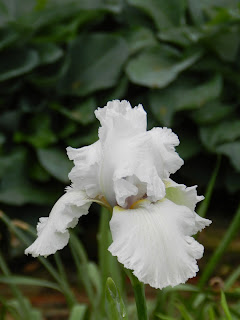Every annual is a perennial somewhere. The trick is we don’t live in the ideal
temperate climates needed for many of these tropical beauties.
Some folks have them as houseplants, a few have greenhouses
and most shun them like the idea of burning dollar bills for fireworks.
I’m not very good at taking care of houseplants, my
overwintering is certainly survival of the most stubborn and even if I had a
greenhouse, I’d probably forget to shut the door one day in January.
I’ve developed a new attitude about tropical plants and
especially foliage. If it costs the same
as some other annuals such as geraniums and Boston ferns, then why not spend
the same amount on these really dramatic and often huge foliage plants?
Some of my favorites are Angels Trumpet (and it does bloom
gloriously), elephant ears, banana, canna, coleus, many grasses (especially
loving King Tut and that cute little fiber optic), and there are some really
large succulents.
If you’re determined to overwinter, pot them and use an
appliance cart to wheel them indoors before frost.
Large plants such as these really do make a dramatic
statement in the garden. An elephant ear
along side a pond will get about four feet tall and look for all the world like
you’ve entered the tropics.
Annual grasses planted directly in the ground will double
(or more) the size you typically see in pots.
They love the freedom and nutrients in the soil.
These dramatic foliages (even those that have blooms) can
fill in a gap caused by something that has died or a grouping that hasn’t
matured.
Even sweet potato vines planted directly into the soil will
form a beautiful mat around your daylilies or other perennials.
It’s an opportunity to introduce vibrant colors. I have a beautiful banana plant in shades of
deep burgundy on shiny emerald green.
The chartreuse sweet potato vine brightens a patch of ground and forms a
beautiful background for bright pinks.
Here in the Midwest we seldom have perennials with large
leaves. Using these annuals allows for
that contrast.
Large succulents can be pretty expensive especially if you
consider throwing them away each winter.
If you’re planning a rock garden or other landscape where these would be
especially stunning, consider planting them in clay pots and then sinking the
pots in the ground. In the fall, you
simply lift and store. If you’re not
able or don’t desire to manhandle large pots, consider planting a fairy garden
of annual succulents in a shallow bowl.
About the only gray/silver foliage plants must be
annuals. We normally see them only in
pots, but I’ve had excellent results when used for borders, accents, and
foundation plants. Dusty Miller is the
most common but there are many others – some creepy other worldly fun.
Caster Bean plants are another huge and beautiful
plant. The only note on this one is the
seeds are poisonous and must be removed or kept away from children and animals.
Begonias, Euphorbia and dahlias are beautiful flowering
plants and folks normally don’t think about their foliage. Both have beautiful leaves and some can get 3
– 4 foot tall.
I recommend planting different varieties of lettuce and
other greens throughout your garden. It
looks great and always good to have a handful ready for a nice salad or
BLT.
And last, are the fall ornamental
cabbages. If you plant them in the
spring, make sure to plant other annuals around them as they may loose some of
the outside leaves.
We may not live in the tropics but
we can certainly take advantage of these tropical beauties - for a season at
least.










.JPG)

.JPG)
.JPG)
.JPG)
.JPG)
.JPG)


.JPG)

.JPG)

.JPG)
.JPG)

.JPG)
